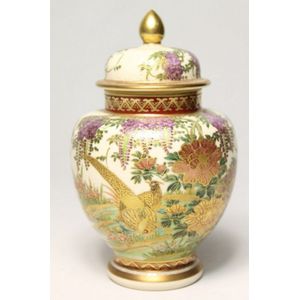Satsuma Jar with Thousand Flower Motif
You must be a subscriber, and be logged in to view price and dealer details.
Subscribe Now to view actual auction price for this item
When you subscribe, you have the option of setting the currency in which to display prices to $Au, $US, $NZ or Stg.
- Cartouche - An ornamental panel in the form of of a shield, oval or rectangular scroll with curling edges. It may be carved into the back of a chair or the top of a sideboard, or present on a piece of silver or jewellery, and contain the initials of the original owner, heraldic symbols, or some other inscription, such as the details of a presentation.
In ceramics the term defines the central area of a vase or similar with a decorative border in one of the shapes above, into which a decorative scene or figures have been painted. - Finial - An architectural decoration, found on the upper parts of of an object. On furniture they are usually found on pediments, canopies and shelf supports. On smaller ceramic or silver items, such as spoons, they may decorate the top of the item itself, or the lid or cover where they provide a useful handle for removal.
Finials have a variety of shapes and forms. They may be urn-shaped, baluster shaped round or spiral, but usually taper into an upper point. Many real life shapes may also be used as finials, such as pineapples, berries, pinecones, buds, lotus and acorns. Sometimes animals such as a lion are depicted, or fish and dolphins. - Oviform /ovoid - The outline loosely resembling the shape of an egg.
- Mon - A mon is a Japanese heraldic emblem, indicating the status or the family of the owner, similar to a family crest. Nowadays almost all Japanese families and many businesses have a mon.
In decorative arts, mon are used as a decorative element on a vase, plate, bowl or item of furniture.
This item has been included into following indexes:
Visually similar items

A Japanese earthenware Satsuma lidded jar, 20th century, featuring a continuous flowering wisteria pattern with long tailed birds on a riverbank with gilt accents. Red and gilt mark to base. Height 15 cm

Japanese Satsuma jar and cover of baluster form, decorated with birds and flowers, in tones of red, green, pink and gilt, seal mark to base, height 23 cm

Royal Worcester Harry Stinton pot pourri vase & cover painted with highland cattle, numbered 278. Height 13 cm

Satsuma Japanese lidded vase, circa 1930s. 24 cm
